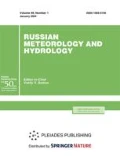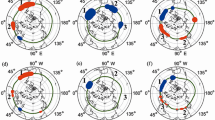Abstract
Many large-scale dynamic phenomena in the Earth’s atmosphere are associated with the processes of propagation and breaking of Rossby waves. A new method for identifying the Rossby wave breaking (RWB) is proposed. It is based on the detection of breakings centers by analyzing the shape of the contours of potential vorticity or temperature on quasimaterial surfaces: isentropic and iserthelic (surfaces of constant Ertel potential vorticity (PV)), with further RWB center clustering to larger regions. The method is applied to the set of constant PV levels (0.3 to 9.8 PVU with a step of 0.5 PVU) at the level of potential temperature of 350 K for 12:00 UTC. The ERA-Interim reanalysis data from 1979 to 2019 are used for the method development. The type of RWB (cyclonic/anticyclonic), its area and center are determined by analyzing the vortex geometry at each PV level for every day. The RWBs obtained at this stage are designated as elementary breakings. Density-Based Spatial Clustering of Applications with Noise algorithm (DBSCAN) was applied to all elementary breakings for each month. As a result, a graphic dataset describing locations and dynamics of RWBs for every month from 1979 to 2019 is formed. The RWB frequency is also evaluated for each longitude, taking into account the duration of each RWB and the number of levels involved, as well as the anomalies of these parameters.


Similar content being viewed by others
REFERENCES
A. R. Ivanova, N. P. Shakina, E. N. Skriptunova, and N. I. Bogaevskaya, “Comparison of Dynamic Characteristics of the Summer 2010 Blocking Anticyclone with Earlier Episodes,” in Analysis of Abnormal Weather Conditions in Russia in the Summer 2010, Ed. by N. P. Shakina (Triada LTD, Moscow, 2011) [in Russian].
I. I. Mokhov, “Action as an Integral Characteristic of Climatic Structures: Estimates for Atmospheric Blockings,” Dokl. Akad. Nauk, No. 3, 409 (2006) [Dokl. Earth Sci., No. 6, 409 (2006)].
I. I. Mokhov, “Specific Features of the 2010 Summer Heat Formation in the European Territory of Russia in the Context of General Climate Changes and Climate Anomalies,” Izv. Akad. Nauk, Fiz. Atmos. Okeana, No. 6, 47 (2011) [Izv., Atmos. Oceanic Phys., No. 6, 47 (2011)].
I. I. Mokhov and A. V. Timazhev, “Atmospheric Blocking and Changes in Its Frequency in the 21st Century Simulated with the Ensemble of Climate Models,” Meteorol. Gidrol., No. 6 (2019) [Russ. Meteorol. Hydrol., No. 6, 44 (2019)].
D. G. Andrews and M. E. McIntyre, “Planetary Waves in Horizontal and Vertical Shear: The Generalized Eliassen–Palm Relation and the Mean Zonal Acceleration,” J. Atmos. Sci., No. 11, 33 (1976).
E. A. Barnes and D. L. Hartmann, “Detection of Rossby Wave Breaking and Its Response to Shifts of the Midlatitude Jet with Climate Change,” J. Geophys. Res. Atmos., No. D9, 117 (2012).
P. Berrisford, B. J. Hoskins, and E. Tyrlis, “Blocking and Rossby Wave Breaking on the Dynamical Tropopause in the Southern Hemisphere,” J. Atmos. Sci., No. 8, 64 (2007).
D. Birant and A. Kut, “ST-DBSCAN: An Algorithm for Clustering Spatial-temporal Data,” Data & Knowledge Eng., No. 1, 60 (2007).
K. A. Bowley, J. R. Gyakum, and E. H. Atallah, “A New Perspective toward Cataloging Northern Hemisphere Rossby Wave Breaking on the Dynamic Tropopause,” Mon. Wea. Rev., No. 2, 47 (2019).
J. G. Charney and P. G. Drazin, “Propagation of Planetary-scale Disturbances from the Lower into the Upper Atmosphere,” J. Geophys. Res., No. 1, 66 (1961).
D. Chyi, Z. Xie, N. Shi, P. Guo, and H. Wang, “Wave-breaking Features of Blocking over Central Siberia and Its Impacts on the Precipitation Trend over Southeastern Lake Baikal,” Adv. Atmos. Sci., No. 1, 37 (2020).
J. Cohen, J. C. Furtado, J. Jones, J. A. Screen, M. Barlow, D. Whittleston, D. Entekhabi, D. Coumou, J. Francis, K. Dethloff, and J. Overland, “Recent Arctic Amplification and Extreme Mid-latitude Weather,” Nature Geoscience, No. 9, 7 (2014).
D. P. Dee, S. M. Uppala, A. J. Simmons, P. Berrisford, P. Poli, S. Kobayashi, U. Andrae, M. A. Balmaseda, G. Balsamo, P. Bauer, P. Bechtold, A. C. M. Beljaars, L. van de Berg, J. Bidlot, N. Bormann, C. Delsol, R. Dragani, M. Fuentes, A. J. Geer, L. Haimberger, S. B. Healy, H. Hersbach, E. V. Hylm, L. Isaksen, P. Kellberg, M. Kohler, M. Matricardi, A. P. McNally, B. M. Monge-Sanz, J.-J. Morcrette, B.-K. Park, C. Peubey, P. de Rosnay, C. Tavolato, J.-N. Thepaut, and F. Vitart, “The ERA-Interim Reanalysis: Configuration and Performance of the Data Assimilation System,” Quart. J. Roy. Meteorol. Soc., No. 656, 137 (2011).
M. Ester, H.-P. Kriegel, J. Sander, and X. Xu, “A Density-based Algorithm for Discovering Clusters in Large Spatial Databases with Noise,” in Data Mining and Knowledge Discovery (1996).
S. B. Feldstein and I. M. Held, “Barotropic Decay of Baroclinic Waves in a Two-layer Beta-plane Model,” J. Atmos. Sci., No. 22, 46 (1989).
J. A. Francis and S. J. Vavrus, “Evidence Linking Arctic Amplification to Extreme Weather in Midlatitudes,” Geophys. Res. Lett., 39 (2012).
P. Groisman, H. Shugart, D. Kicklighter, G. Henebry, N. Tchebakova, E. Kukavskaya, S. Maksyutov, E. Monier, G. Gutman, S. Gulev, J. Qi, J. Chen, A. Prishcherov, B. Porfiriev, A. Shiklomanov, T. Loboda, N. Shiklomanov, S. Nghiem, K. Bergen, J. Albrechtova, M. Shahgedanova, A. Shvidenko, N. Speranskaya, A. Soja, K. De Beurs, O. Bulygina, J. Mccarty, Q. Zhuang, and O. Zolina, “Northern Eurasia Future Initiative (NEFI): Facing the Challenges and Pathways of Global Change in the Twenty-first Century,” Progress in Earth and Planetary Science, No. 1, 4 (2017).
D. E. Horton, N. C. Johnson, D. Singh, D. L. Swain, B. Rajaratnam, and N. S. Diffenbaugh, “Contribution of Changes in Atmospheric Circulation Patterns to Extreme Temperature Trends,” Nature, No. 7557, 522 (2015).
C. S. Y. Huang and N. Nakamura, “Local Finite-amplitude Wave Activity as a Diagnostic of Anomalous Weather Events,” J. Atmos. Sci., No. 1, 73 (2015).
P. Jing and S. Banerjee, “Rossby Wave Breaking and Isentropic Stratosphere-troposphere Exchange during 1981–2015 in the Northern Hemisphere,” J. Geophys. Res. Atmos., No. 17, 123 (2018).
W. K. M. Lau and K.-M. Kim, “The 2010 Pakistan Flood and Russian Heat Wave: Teleconnection of Hydrometeorological Extremes,” J. Hydrometeorol., No. 1, 13 (2012).
H. Lejenas and H. Okland, “Characteristics of Northern Hemisphere Blocking as Determined from a Long Time Series of Observational Data,” Tellus A, No. 5, 35 (1983).
A. R. Lupo, R. J. Oglesby, and I. I. Mokhov, “Climatological Features of Blocking Anticyclones: A Study of Northern Hemisphere CCM1 Model Blocking Events in Present-day and Double CO2 Concentration Atmospheres,” Climate Dynamics, No. 3, 13 (1997).
A. R. Lupo, I. I. Mokhov, G. Chendev, M. G. Lebedeva, M. Akperov, and J. A. Hubbart, “Studying Summer Season Drought in Western Russia,” Adv. Meteorol., 2014 (2014).
G. Masato, B. J. Hoskins, and T. J. Woollings, “Wave-breaking Characteristics of Midlatitude Blocking,” Quart. J. Roy. Meteorol. Soc., No. 666, 138 (2012).
T. Matsuno, “A Dynamical Model of the Stratospheric Sudden Warming,” J. Atmos. Sci., No. 8, 28 (1971).
M. E. McIntyre and T. N. Palmer, “A Note on the General Concept of Wave Breaking for Rossby and Gravity Waves,” Pure and Appl. Geophys. PAGEOPH, No. 6, 123 (1985).
M. E. McIntyre and T. N. Palmer, “Breaking Planetary Waves in the Stratosphere,” Nature, No. 5935, 305 (1983).
I. I. Mokhov, A. V. Timazhev, and A. R. Lupo, “Changes in Atmospheric Blocking Characteristics within the Euro-Atlantic Region and Northern Hemisphere as a Whole in the 21st Century from Model Simulations Using RCP Anthropogenic Scenarios,” Glob. Planet. Change, 122 (2014).
J. L. Pelly and B. J. Hoskins, “A New Perspective on Blocking,” J. Atmos. Sci., No. 3, 60 (2003).
G. A. Postel and M. H. Hitchman, “A Climatology of Rossby Wave Breaking along the Subtropical Tropopause,” J. Atmos. Sci., No. 3, 56 (1999).
R. S. Quiroz, “The Association of Stratospheric Warmings with Tropospheric Blocking,” J. Geophys. Res., No. D4, 91 (1986).
J. A. Renwick and J. M. Wallace, “Relationships between North Pacific Wintertime Blocking, El Nino, and the PNA Pattern,” Mon. Wea. Rev., No. 9, 124 (1996).
S. D. Schubert, H. Wang, R. D. Koster, M. J. Suarez, and P. Y. Groisman, “Northern Eurasian Heat Waves and Droughts,” J. Climate, No. 9, 27 (2014).
N. Shi, X. Wang, L. Zhang, and H. Xu, “Features of Rossby Wave Propagation Associated with the Evolution of Summertime Blocking Highs with Different Configurations over Northeast Asia,” Mon. Wea. Rev., No. 7, 144 (2016).
A. J. Simmons and B. J. Hoskins, “Barotropic Influences on the Growth and Decay of Nonlinear Baroclinic Waves,” J. Atmos. Sci., No. 8, 37 (1980).
C. Strong and G. Magnusdottir, “Tropospheric Rossby Wave Breaking and the NAO/NAM,” J. Atmos. Sci., No. 9, 65 (2008).
C. D. Thorncroft, B. J. Hoskins, and M. E. Mcintyre, “Two Paradigms of Baroclinic-wave Life-cycle Behavior,” Quart. J. Roy. Meteorol. Soc., No. 509, 119 (1993).
S. Tibaldi and F. Molteni, “On the Operational Predictability of Blocking,” Tellus A, No. 3, 42 (1990).
E. Tyrlis and B. J. Hoskins, “The Morphology of Northern Hemisphere Blocking,” J. Atmos. Sci., No. 5, 65 (2008).
G. Wolf and V. Wirth, “Diagnosing the Horizontal Propagation of Rossby Wave Packets along the Midlatitude Waveguide,” Mon. Wea. Rev., No. 8, 145 (2017).
X. Zhang, C. Lu, and Z. Guan, “Weakened Cyclones, Intensified Anticyclones and Recent Extreme Cold Winter Weather Events in Eurasia,” Environ. Res. Lett., No. 4, 7 (2012).
Funding
The research was supported by the Russian Science Foundation (grant 19-17-00248 “Hydrodynamic Instability and Large-scale Vortex Dynamics of the Atmosphere in a Changing Climate”). The testing of the DBSCAN algorithm parameters was partly supported by the infrastructure of Zuev Institute of Atmospheric Optics (Siberian Branch of Russian Academy of Sciences) developed and operating according to the Governmental Assignment AААА-А17-117021310142-5, including the Atmosfera Common Use Center.
Author information
Authors and Affiliations
Corresponding author
Additional information
Russian Text ©The Author(s), 2021, published in Meteorologiya i Gidrologiya, 2021, No. 1, pp. 17-28.
About this article
Cite this article
Gochakov, A.V., Antokhina, O.Y., Krupchatnikov, V.N. et al. Method for Identifying and Clustering Rossby Wave Breaking Events in the Northern Hemisphere. Russ. Meteorol. Hydrol. 46, 10–18 (2021). https://doi.org/10.3103/S1068373921010027
Received:
Revised:
Accepted:
Published:
Issue Date:
DOI: https://doi.org/10.3103/S1068373921010027




